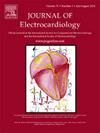Age, sex, hypertension and the sensitivity and specificity of traditional, new and a machine learning ECG criteria for prediction of left ventricular hypertrophy
IF 1.3
4区 医学
Q3 CARDIAC & CARDIOVASCULAR SYSTEMS
引用次数: 0
Abstract
Objective
To evaluate the impact of age, sex and hypertension to improve ECG diagnosis of Left Ventricular Hypertrophy (LVH).
Methods
The study evaluated 14 different QRS voltage criteria as well as our recently proposed criteria of S in V3 plus S in V4 in a population of 159 patients, of whom 14.5 % had echocardiographic evidence of LVH. Statistical analyses assessed the influence of age, sex, and hypertension on the sensitivity and specificity of each criterion. In addition, a machine learning model was used for enhanced diagnostic accuracy.
Results
The new SV3 + SV4 criterion had the highest F1 and AUC scores. Among traditional ECG criteria, the Peguero criterion showed the highest sensitivity (0.438), while Wilson and Mazeloni criteria demonstrated the highest specificity (0.9412). The new SV3 + SV4 criterion with sex-specific cut offs achieves a sensitivity of 0.500 and specificity of 0.809 in females, while in males, sensitivity reached 0.556 with specificity at 0.910. Multiple regression analysis indicated that age, sex, and hypertension significantly improved the diagnostic performance of specific criteria, including Sokolow-Lyon, Romhilt voltage, Murphy, and Grant criteria. However, other criteria were not impacted by considering age, sex, or hypertension. ML analysis improved diagnostic accuracy with clinical variables, with the highest performance in males with the addition of age (accuracy 0.959, sensitivity 0.556, and specificity 1.00).
Conclusion
Considering age, sex, and hypertension can enhance the diagnostic performance of certain ECG criteria and especially in a ML model for LVH. Findings support a more individualized approach for LVH diagnosis in diverse patient populations.

年龄、性别、高血压及传统、新型和机器学习心电图预测左室肥厚标准的敏感性和特异性
目的探讨年龄、性别和高血压对左室肥厚(LVH)心电图诊断的影响。方法本研究对159例LVH患者进行了14种不同的QRS电压标准以及我们最近提出的V3 S + V4 S标准,其中14.5%有LVH超声心动图证据。统计分析评估了年龄、性别和高血压对每个标准的敏感性和特异性的影响。此外,还使用了机器学习模型来提高诊断准确性。结果新SV3 + SV4标准的F1和AUC评分最高。在传统心电图判据中,Peguero判据敏感性最高(0.438),Wilson和Mazeloni判据特异性最高(0.9412)。新的SV3 + SV4标准具有性别特异性截断值,女性的敏感性为0.500,特异性为0.809,而男性的敏感性为0.556,特异性为0.910。多元回归分析显示,年龄、性别和高血压显著提高了Sokolow-Lyon、Romhilt voltage、Murphy和Grant等特定标准的诊断效能。然而,其他标准不受年龄、性别或高血压的影响。ML分析提高了临床变量的诊断准确性,随着年龄的增加,男性的诊断准确率最高(准确率0.959,敏感性0.556,特异性1.00)。结论考虑年龄、性别和高血压可以提高某些心电图标准的诊断效能,尤其是在LVH的ML模型中。研究结果支持对不同患者群体进行LVH诊断的更加个性化的方法。
本文章由计算机程序翻译,如有差异,请以英文原文为准。
求助全文
约1分钟内获得全文
求助全文
来源期刊

Journal of electrocardiology
医学-心血管系统
CiteScore
2.70
自引率
7.70%
发文量
152
审稿时长
38 days
期刊介绍:
The Journal of Electrocardiology is devoted exclusively to clinical and experimental studies of the electrical activities of the heart. It seeks to contribute significantly to the accuracy of diagnosis and prognosis and the effective treatment, prevention, or delay of heart disease. Editorial contents include electrocardiography, vectorcardiography, arrhythmias, membrane action potential, cardiac pacing, monitoring defibrillation, instrumentation, drug effects, and computer applications.
 求助内容:
求助内容: 应助结果提醒方式:
应助结果提醒方式:


